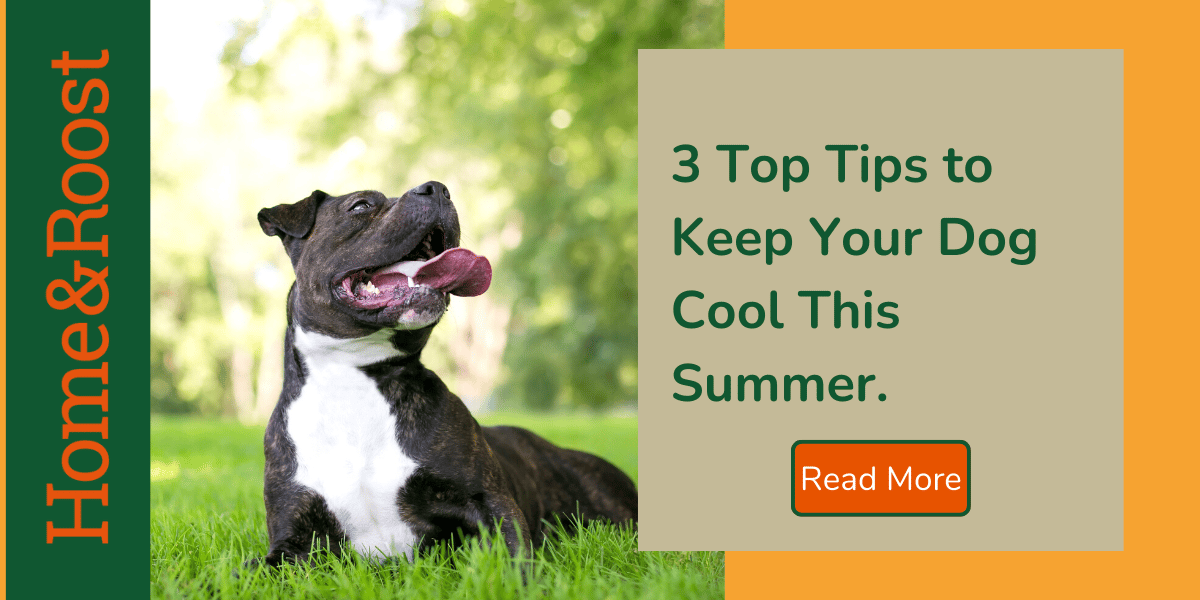If you have a dog or a puppy, you know that overheating can be a real cause for concern during the summer months. But with the right planning ahead of time, you can reduce the risk of heatstroke and help protect your four-legged best friend from the heat. We’ll take a look at:
- Signs and symptoms of heat stroke
- How to plan your walks in the summer
- Protecting their paws
- Other ways of keeping your dog cool
So, keep reading as we share some top tips to help eliminate worry and keep your dog (or any outside pet) cool this summer, so you can focus on making memories with man’s best friend…
Higher Risk
Dogs are more at risk of heat stroke than humans are. They essentially have coats on throughout the year and cannot sweat through their skin. Instead, they cool themselves by panting, drinking and releasing heat from their paw pads.

Heatstroke is often deadly, as the rise in internal temperature can be quick and potentially cause organ failure. According to UK clinical veterinary records, 1 out of 7 dogs that go to the vet for heatstroke do not survive, which means early prevention is crucial for dog owners.
Whilst any dog can develop heatstroke, there are a few characteristics that put some at higher risk than others:
- Being overweight,
- Being older
- Having long or thick fur
- Flat-faced breeds
- Dogs with existing health issues.
Signs and symptoms of heat stroke
You may not see all the signs of heatstroke at once, but if you see one or two symptoms, you need to act fast. The warning signs of heatstroke include:
- Increased heart rate
- Excessive drooling
- Heavy panting
- Appearing sleepy or lethargic
- Collapsing
- Confusion
- Being sick
- Issues breathing
To give them the best chance of survival, you’ll need to find a way of reducing their body temperature.
Firstly, cease any exercise and get them somewhere cool and in the shade, preferably lying down on a cool floor. Next, pour cool water over the dog – ensure the water isn’t freezing as that can cause shock. You can also use a sponge to apply water, focusing on their tummy, inner thighs and neck. Placing a fan near the dog or putting them in an air-conditioned room and allowing them to take small drinks of water can help too.
It’s important to contact your vet as a matter of urgency, and once your dog has cooled down, seek professional help as soon as you can. Even if your dog seems to have recovered, they may still need emergency intervention as there might already be damage done or additional health risks to consider.
How to plan walks in the summer
Leaving a dog in a hot car can become dangerous very quickly, but heatstroke most commonly happens due to exercise in warm weather.
It’s best to avoid the hottest part of the day and opt for walks in the early morning or late evening to avoid being out in the blazing heat. You could also choose shaded walks in woody areas where the ground and air are cooler. Either way, be sure to carry water for your dog and take along a bowl to encourage them to drink – collapsible bowls are especially useful for summer walks.

Keep an eye out for any signs of heatstroke, such as excessive panting or loss of energy. If you notice them, react immediately by taking your dog into the shade and giving them water to drink.
Protecting your dog’s paws
Since we humans wear shoes outside, we often don’t realise how hot the ground gets when the sun is out. Surfaces such as asphalt, tarmac, artificial grass or sand really hold on to the heat and can harm your pup’s paws.
You can test the temperature by placing the back of your hand on the ground for 7 seconds – if it’s too hot for your hand, it’s too hot for your dog’s paws.
If they really need a walk, there are a few things you can do to help protect them, including:
- Walking on natural grass
- Consider specialist dog booties or shoes to protect their foot pads
- Consider using paw wax
- Check your dog’s paw pads before & after walks
It only takes a minute for your dogs’ paws to start to burn and blister once on a hot surface, so if you aren’t sure if it’s safe, don’t take the risk.
Other ways of keeping your dog cool
Whilst dogs are most at risk of heatstroke during walks and exercise, there can be other causes, so you should aim to make your home and garden as safe and cool as possible. For example, ensure that your dog isn’t left in a hot room such as the conservatory, and make sure they always have fresh, cool water to drink.

You can also put down damp, cold towels in the shade for them to lie on, fill up a doggy paddling pool or purchase a specialist dog cooling pad.
Another great way to help your dog stay cool is by creating frozen treats by making ice cubes out of their favourite wet food or adding ice cubes to their water bowls. If your dog has thick or long hair, keep them clipped and groomed regularly during the summer months and brush them often to keep their coats thin.
Protect, Prepare and Plan, for a Cool Comfortable Summer for Your Pooch
So, there you have it – with adequate preparation, caution and planning, you will be able to dramatically reduce the risk of your dog getting heatstroke this summer. It’s the same for any outside pet, to be honest – just prepare, keep them cool and enjoy the season with your four-legged best friend.

















Leave a Reply